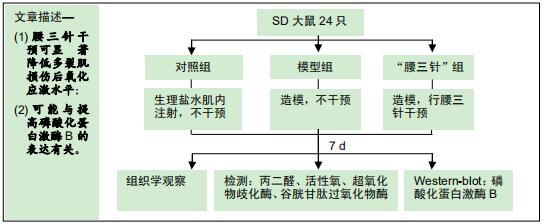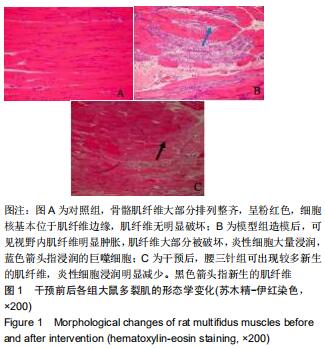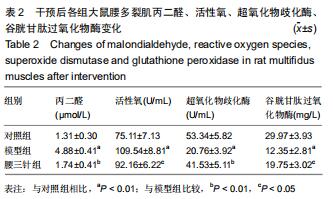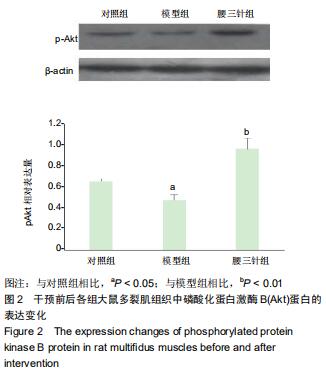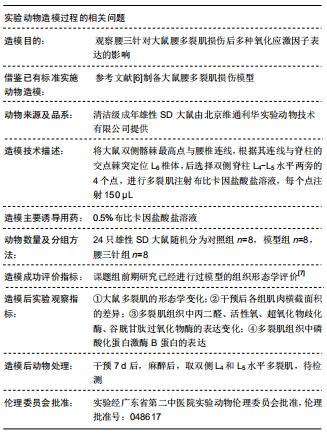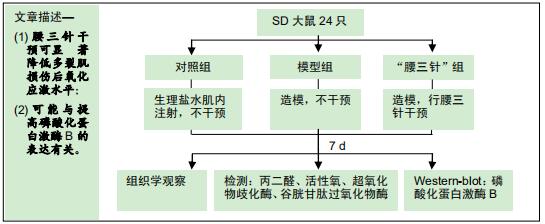|
[1] SNIDER RK. A prospective, randomized study of lumbar fusion: preliminary results.Spine.1994;19(1):109.
[2] AGHION D, CHOPRA P, OYELESE A A. Failed back syndrome.Med Health R I. 2012;95(12):391-393.
[3] DZIK K, SKROBOT W, FLIS DJ, et al. Vitamin D supplementation attenuates oxidative stress in paraspinal skeletal muscles in patients with low back pain. Eur J Appl Physiol. 2018;118(1):143-151.
[4] 刘通,于佳妮,邹德辉,等.电针血清对多裂肌卫星细胞增殖及Pax-7、成肌分化抗原、磷酸化蛋白激酶B表达的影响[J].针刺研究, 2016,41(5):402-409.
[5] 刘通,于佳妮,邹德辉,等.电针调控miRNA206/HDAC4轴促进损伤多裂肌修复过程中成肌细胞分化的机制[J].中国组织工程研究,2019,23(33):5341-5346.
[6] TAGUCHI T, HOHEISEL U, MENSE S.Dorsal horn neurons having input from low back structures in rats. Pain. 2008; 138:119–129.
[7] 陈玉佩,刘通,邹德辉,等.局部注射布比卡因建立大鼠骨骼肌损伤模型的组织形态学评价[J].中国组织工程研究,2016,20(18): 2615-2621.
[8] 李忠仁. 实验针灸学[M].北京:中国中医药出版社, 2003:316.
[9] HUNG CW, WU MF, HONG RT, et al. Comparison of multifidus muscle atrophy afterposterior lumbar interbody fusion with conventional and cortical bone trajectory. Clin Neurol Neurosurg. 2016;145:41-45.
[10] CHA JR, KIM YC, JANG C, et al. Pedicle screw fixation and posterior fusion for lumbar degenerative diseases: effects on individual paraspinal muscles and lower back pain; a single-center, prospective study. BMC Musculoskelet Disord. 2016;17:63.
[11] GILBERT F, HEINTEL TM, JAKUBIETZ MG, et al. Quantitative MRI comparison of multifidus muscle degeneration in thoracolumbar fractures treated with open and minimally invasive approach.BMC Musculoskelet Disord. 2018;19(1):75.
[12] YARJANIAN JA, FETZER A, YAMAKAWA KS, et al. Correlation of Paraspinal Atrophy and Denervation in Back Pain and Spinal Stenosis Relative to Asymptomatic Controls. PM&R.2013;5(1):39-44.
[13] WASCHKE A, HARTMANN C, WALTER J, et al. Denervation and atrophy of paraspinal muscles after open lumbar interbody fusion is associated with clinical outcome-electromyographic and CT-volumetric investigation of 30 patients. ActaNeurochirurgica.2014;156(2):235-244.
[14] GILLE O, JOLIVET E, DOUSSET V, et al. Erector Spinae Muscle Changes on Magnetic Resonance Imaging Following Lumbar Surgery Through a Posterior Approach. Spine. 2007; 32(11):1236-1241.
[15] 季传婷,徐平,谢龙.电针对Cardiotoxin肌肉损伤小鼠MyoD表达的影响[J].南京中医药大学学报, 2012,28(2):136-138.
[16] WATANABE K, MATSUMOTO M, IKEGAMI T, et al. Reduced postoperative wound pain after lumbar spinous process–splitting laminectomy for lumbar canal stenosis: a randomized controlled study. J Neurosurg Spine. 2011;14(1): 51-58.
[17] 房芳,魏艳霞.腰三针治疗腰椎间盘突出症的临床观察及影像学变化[J].世界中医药,2018,13(5):1250-1253+1257.
[18] 曲淑婕,张帅,戈磊,等.腰三针配合穴位推拿对LDH患者治疗效果及超氧化物歧化酶和α1-AGP水平影响[J].辽宁中医药大学学报,2019,21(5):211-214.
[19] 张洁.腰三针温针灸治疗退行性腰椎管狭窄症的临床效果观察[J].临床医药文献电子杂志,2018,5(90):45+47.
[20] HALLIWELL B. Biochemistry of oxidative stress. Biochem Soc Trans. 2007;35(Pt 5):1147-1150.
[21] LU K, LIANG CL, CHO CL, et al. Oxidative stress and heat shock protein response in human paraspinal muscles during retraction.J Neurosurg. 2002;97(1 Suppl):75-81.
[22] LU K, LIANG CL, CHEN HJ, et al. Nuclear factor-kappaB- regulated cyclooxygenase-2 expression in surgery-associated paraspinal muscle injury in rats.J Neurosurg. 2003 Mar;98(2 Suppl):181-187.
[23] 胡志军. 腰椎后路手术原性多裂肌损伤和萎缩的相关研究:解剖基础和因素分析[D].杭州:浙江大学, 2012.
[24] REDDY NM, POTTETI HR, VEGIRAJU S, et al. PI3K-AKT Signaling via Nrf2 Protects against Hyperoxia-Induced Acute Lung Injury, but Promotes Inflammation Post-Injury Independent of Nrf2 in Mice. Plos One. 2015;10(6):e0129676.
[25] LIEN EC, LYSSIOTIS CA, JUVEKAR A, et al. Glutathione biosynthesis is a metabolic vulnerability in PI(3)K/Akt-driven breast cancer. Nat Cell Biol. 2016;18(5):572-578.
[26] 陈伟巍,王敏,吴明辉.Trx-1过表达通过NF-κB信号通路减轻MPP~+所致PC12细胞的氧化应激损伤[J].中国病理生理杂志, 2019,35(07):1206-1212.
[27] 王宇霆. 乌司他丁通过Akt/mTOR通路保护受氧化应激的人脐静脉血管内皮细胞[D].杭州:浙江大学,2013.
|
